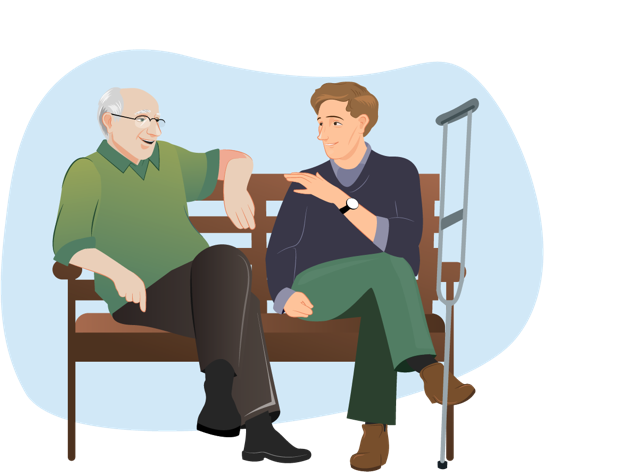
The Importance of Regular Exercise and Physical Activity in Live in Care



Speak to one of our experts
Our friendly experts are here to help from 9am to 7pm, 7 days a week.
Healthy Lifestyle
Maintaining a healthy lifestyle, including regular physical exercise, is crucial for the elderly population in a live-in care setting. Exercise helps improve cardiovascular health, strengthen muscles and bones, enhance flexibility, and boost overall well-being.
It also reduces the risk of chronic diseases, improves mood, and promotes social interaction. This blog delves into specific exercises and their benefits for elderly individuals, ensuring a fulfilling and vibrant life in their later years.
How Physical Exercise Can Improve the Health of the Elderly
Regular exercise has been consistently shown to have numerous health-enhancing effects for older adults. These benefits extend to various aspects of health, including mobility, mental well-being, and longevity.
Here is some of the scientific rationale and evidence supporting the positive effects of exercise in older adults:
Improved mobility:
Engaging in activities that promote strength, flexibility, and balance can reduce the risk of falls and enhance overall mobility. Studies have demonstrated that exercise interventions, such as resistance training and tai chi, can improve muscle strength, balance, and gait in older adults.
Cardiovascular health:
Regular aerobic exercise can help lower blood pressure, improve blood circulation, and reduce the risk of cardiovascular diseases such as heart disease and stroke. Studies have shown that older adults who engage in regular aerobic exercise have improved cardiovascular fitness and reduced mortality rates compared to sedentary individuals.
Cognitive function:
Regular physical activity has been associated with a lower risk of cognitive decline, dementia, and Alzheimer’s disease. Exercise promotes neuroplasticity, the ability of the brain to adapt and form new connections, which can enhance cognitive function and protect against age-related cognitive decline.
Mood and mental well-being:
Physical activity stimulates the release of endorphins, known as “feel-good” hormones. Regular exercise can reduce symptoms of depression and anxiety, enhance self-esteem, and improve overall psychological well-being.
Bone health:
Older adults are at an increased risk of osteoporosis and fractures. Weight-bearing exercises, such as walking, jogging, or resistance training, can help improve bone density and reduce the risk of fractures. They stimulate the formation of new bone tissue and can help maintain bone strength and integrity.
Longevity:
Studies have consistently shown that physically active individuals have a reduced risk of premature death compared to those who are sedentary. Moderate-intensity aerobic exercise, such as brisk walking, for at least 150 minutes per week has been recommended for improving overall longevity.
Chronic disease prevention:
Physical activity can help reduce the risk of type 2 diabetes, certain cancers, osteoarthritis, and age-related macular degeneration. Exercise promotes healthy weight management, improves insulin sensitivity, and enhances immune function.
The Benefits That Exercise Creates for Live in Care Situations
Exercise is particularly important in live-in care scenarios. Regular physical activity can yield significant benefits for the care recipient and the caregiver. For care recipients, regular exercise is key to managing various health conditions such as diabetes, heart disease, and osteoporosis.
It can lower blood pressure, strengthen the immune system, and improve digestion. It also contributes to better sleep and increased energy levels. Exercise is proven to reduce the symptoms of depression, anxiety, and stress. In the case of dementia patients, physical activity can slow cognitive decline and improve overall brain health.
Regular exercise can improve strength, flexibility, and balance. This can make a person more self-sufficient in daily activities like dressing, eating, and bathing, reducing their reliance on caregivers. Care recipients can experience greater achievement and personal satisfaction by participating in physical activities.
The caregivers’ workload may reduce as the care recipient’s physical health and independence improve. This can free up more time for self-care, a critical factor in preventing caregiver burnout. Encouraging and participating in physical activities with care recipients can motivate caregivers to maintain a healthier lifestyle. Shared activities can promote bonding and mutual understanding, making caregiving more satisfying.
Examples of Ideal Exercise Activities for the Elderly
Because our minds and body are interconnected, what benefits the body often benefits the brain. Regular exercise helps to improve your memory and cognitive skills, according to Dr Scott McGinnis, an instructor in neurology at Harvard Medical School.
Here are some exercise activities that are ideal for the elderly in live in care:
Walking: a low-impact exercise that can be tailored to the care recipient’s abilities. It can be done indoors or outdoors and is excellent for cardiovascular health and muscle strength.
Chair exercises: For those with mobility limitations, chair exercises can be a great option. These can include leg lifts, arm raises, and stretches.
Yoga or Tai Chi: these low-impact activities promote flexibility, strength, balance, and calm. They can be modified to accommodate different ability levels.
Resistance training: using light weights or resistance bands can help improve strength and muscle tone. Always ensure these exercises are performed under proper guidance to prevent injury.
Aqua therapy: swimming or water aerobics provide a full-body workout that’s easy on the joints.
Gardening: as well as the physical benefits, it also promotes a sense of accomplishment and a connection with nature.
Conclusion
Regular exercise and physical activity play a pivotal role in promoting the health and well-being of the elderly in live-in care situations. By incorporating appropriate exercises into their daily routine, caregivers can help improve cardiovascular health, mobility, cognitive function, and overall mental well-being.
Exercise provides an opportunity for social interaction and can prevent muscle atrophy, reducing the risk of falls and injuries. To ensure safety and effectiveness, it is advisable to consult with healthcare professionals when planning exercise programs for the elderly. By prioritising regular physical activity, we can contribute to the overall quality of life for those in live-in care. Older adults must consult with healthcare professionals before starting any exercise program to ensure it is safe and suitable for their needs.
Find the Expert Advice You Need by Calling The Live In Care Company
The Live in Care Company provides comprehensive live-in care packages tailored to meet the specific needs of individuals and their families. Our experienced and compassionate carers live with the person requiring care in the comfort of their own home, ensuring round-the-clock support, companionship and lots of mental stimulation.
By opting for live-in care, families can gain peace of mind knowing that their loved ones are receiving professional care in a familiar environment. To learn more about our services and packages, contact us today.






